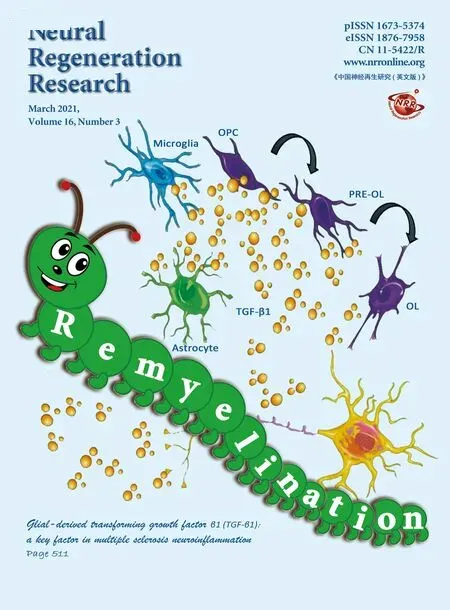中国神经再生研究(英文版)
- Progress in clinical trials of cell transplantation for the treatment of spinal cord injury: how many questions remain unanswered?
- Postnatal therapeutic approaches in genetic neurodevelopmental disorders
- Regulation of neuroimmune processes by damage- and resolution-associated molecular patterns
- Neonatal opioid exposure: public health crisis and novel neuroinflammatory disease
- Physiopathology of ischemic stroke and its modulation using memantine: evidence from preclinical stroke
- MicroRNAs as diagnostic and prognostic biomarkers of age-related macular degeneration: advances and limitations
- Targeting the core of neurodegeneration: FoxO, mTOR, and SIRT1
- Microglial activation and adult neurogenesis after brain stroke
- The therapeutic potential of targeting exchange protein directly activated by cyclic adenosine 3′,5′-monophosphate (Epac) for central nervous system trauma
- Role of vitamin B12 deficiency in ischemic stroke risk and outcome
- Current scenario of the genetic testing for rare neurological disorders exploiting next generation sequencing
- Connexin therapeutics: blocking connexin hemichannel pores is distinct from blocking pannexin channels or gap junctions
- Saccharomyces cerevisiae in neuroscience: how unicellular organism helps to better understand prion protein?
- Neurogenesis versus neurodegeneration: the broken balance in Alzheimer’s disease
- Is serine racemase (SRR) a second hit target for LRRK2-G2019S induced Parkinson’s disease?
- Targeting mechanisms in cognitive training for neurodegenerative diseases
- Targeting metabolism to treat multiple sclerosis
- Brain angiotensin II in dopaminergic imbalance-derived pathologies: neuroinflammation and vascular responses
- Dysfunction of axonal transport in normal-tension glaucoma: a biomarker of disease progression and a potential therapeutic target
- Continued development of azithromycin as a neuroprotective therapeutic for the treatment of spinal cord injury and other neurological conditions
- Glial-derived transforming growth factor β1 (TGF-β1): a key factor in multiple sclerosis neuroinflammation
- Psychosis symptoms following aberrant immunity in the brain
- Temporal changes in inflammatory mitochondriaenriched microRNAs following traumatic brain injury and effects of miR-146a nanoparticle delivery
- Atorvastatin combined with low-dose dexamethasone for vascular endothelial cell dysfunction induced by chronic subdural hematoma
- Changes in sensorimotor regions of the cerebral cortex in congenital amusia: a case-control study
- Solid lipid nanoparticles loading with curcumin and dexanabinol to treat major depressive disorder
- Lycium barbarum polysaccharide-glycoprotein preventative treatment ameliorates aversive stimuli-induced depression
- Combination of epidural electrical stimulation with ex vivo triple gene therapy for spinal cord injury: a proof of principle study
- Liproxstatin-1 is an effective inhibitor of oligodendrocyte ferroptosis induced by inhibition of glutathione peroxidase 4
- Influence of spinal cord injury on core regions of motor function
- Epidural electrical stimulation effectively restores locomotion function in rats with complete spinal cord injury
- Effect of intensity-modulated radiation therapy on sciatic nerve injury caused by echinococcosis
- Anxiety, depression, and quality of life in Parkinson’s disease: the implications of multidisciplinary treatment
- Creatine kinase in the diagnosis and prognostic prediction of amyotrophic lateral sclerosis: a retrospective case-control study
- Guanosine-5′-triphosphate cyclohydrolase 1 regulated long noncoding RNAs are potential targets for microglial activation in neuropathic pain

